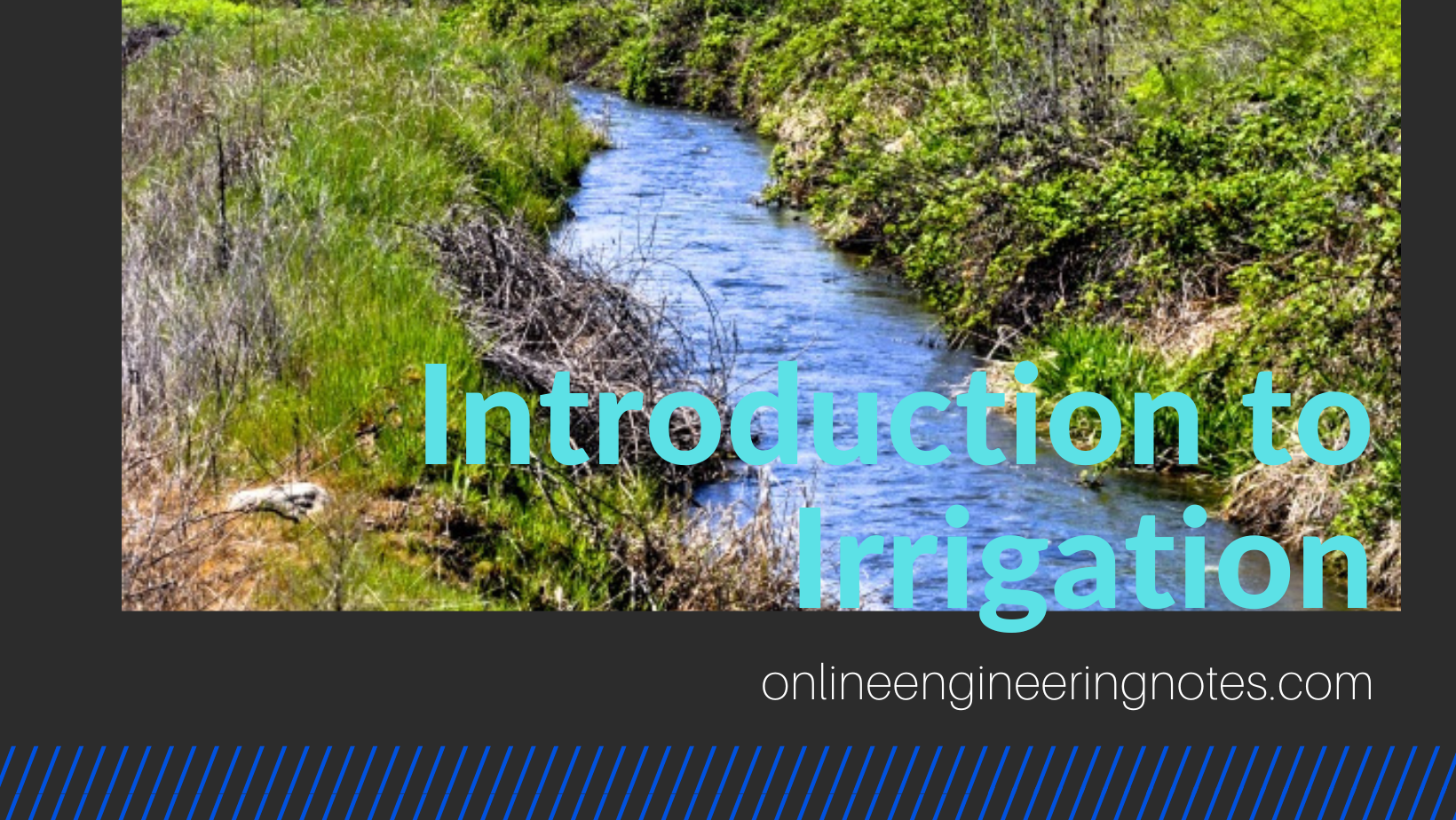Water is the basis of life. All plants and animals require water throughout their lives. In Irrigation Engineering, we are concerned with requirement of water to the plants. Different plants required different quantity of water for their growth and development. Water is naturally available to the plants through rainfall or natural flood. During the times of high stage in river, the land gets saturated and plants extract water from the soil through their roots.
Different places in the earth have different climatic conditions. Some places may get frequent rainfall throughout the year while some may avail them- selves with scanty rainfall. The regions in earth which receive very scanty rainfall are called ”Arid regions”. Some regions in earth may receive precipitation below potential evapotranspiration. These regions are called ”Semi- Arid regions”. Meanwhile ”Tropical wet regions” that lie near the equator receive continuous rainfall throughout the year.
If the natural rainfall is not sufficient to meet the water needs of the plants, water has to be supplied to the plants artificially.
1.1 Definition of irrigation
The artificial application of water to the land throughout the certain du- ration according to the water requirement of a particular crop for its full development is called irrigation. It means if effective rainfall in a particular place is 50 mm and plant water requirement is 80 mm, then 30 mm has to be supplied artificially. Only the water that has been applied to plants artificially comes under irrigation.
Necessity of irrigation
⋆ Diversity of climate and topography
Due to climate and topography, different crops are grown in different parts of the country. Different crops have different requirements of water. Irrigation is necessary to fulfill this requirement.
⋆ Uneven distribution of rainfall
Since the distribution of rainfall is not uniform throughout the country, irrigation is necessary to supplement the deficit water to the plants.
⋆ Inadequate rainfall
Some part of crop water requirement is fulfilled by the rainwater. How- ever, if the rainfall is inadequate, irrigation is necessary to fulfill the deficit water.
⋆ Growing more number of crops
More number of crops can be grown if irrigation is available to meet their needs.
⋆ Increase in production
Sufficient irrigation is necessary to increase crop production.
1.2 Classification/ types of irrigation systems
Irrigation systems are broadly classified into two types:
1. Surface irrigation
The process of irrigation in which water is supplied to the soil surface is called surface irrigation.
It is further divided into two types:
a. Flow irrigation
When the water available at higher location is supplied to the lower level under the action of gravity, it is called flow irrigation.
i. Perennial irrigation
The system of irrigation in which constant and continuous water supply is assured to the crops in accordance with the crop water requirement throughout the crop period is called perennial irrigation.
ii. Direct irrigation
When irrigation is done by diverting the river runoff into the main canal by constructing a diversion weir or barrage across the river, then it is called direct irrigation.
iii. Storage irrigation
When a dam is constructed to store the monsoon water and use it for irrigation during period of low flow, it is called storage irrigation.
iv. Flood irrigation
The type of irrigation in which soil is kept submerged and thoroughly flooded with water so as to cause thorough saturation of the land is called flood irrigation. This soaked moisture supplemented by the natural rain brings the crop to maturity.
b. Lift irrigation
If the water is lifted up by some manual or mechanical means such as pumps and then supplied for irrigation, it is called lift irrigation. Wells and tube wells are used for this purpose.
2. Sub surface irrigation
In sub surface irrigation, water is not supplied to the soil surface. In- stead it is provided beneath the soil surface and this water is extracted by the plant by capillary.
a. Natural sub irrigation
Leakages of water from channels and passage through the sub soil may irrigate crops by capillarity. When underground irrigation is achieved simply without extra efforts, it is called natural sub irrigation.
b. Artificial sub irrigation
When a system of open jointed drains is artificially laid below the soil to supply water to the crops, it is known as artificial sub irrigation. It is costly process and hence applied in small scale for crops with high return.
1.3 Functions and advantages of irrigation
Advantages of irrigation
- Increase in food production
Fulfillment of crop water requirement by irrigation increases crop yield.
- Elimination of mixed cropping
Mixed cropping means sowing together two or more crops in the same field. This process is suitable where irrigation facilities are lacking. Thus, if irrigation is assured, mixed cropping can be elimated.
- Prosperity of the nation
Revenue returns from irrigation projects is high which helps in overall development and prosperity of nation.
- Elimination of famine
Irrigation fulfills crop water requirement and increases crop production eliminating the possible famine.
- Domestic water supply
Though the main purpose of irrigation is to provide water to the fields, this water can be used by local people for washing, bathing and as drinking water for animals.
- Facilities of communication
Development of irrigation project provides access to the embankments and roads which provide facilities of communication and transportation of people and goods.
- Navigation
Large scale irrigation projects can be used for navigation and recreational purposes.
Disadvantages of irrigation
- Irrigation may contribute to the water pollution.
Different chemical fertilizers and pesticides are used in field. These are poisonous to health. When these chemicals get mixed with water and reach the water sources, they may cause water pollution thus affecting aquatic lives and human health.
- Irrigation may result in damp and marshy area causing breeding of mosquitoes
- Over irrigation may lead to water logging and may reduce crop yields
- Development of irrigation projects is costly and complex
- Loss of valuable land:
If case of storage irrigation system, valuable land may get submerged directly or due to rise in water table thus reducing its value.
1.4 Irrigation development in Nepal
History of irrigation development
- Before 1922, only FMIS famer managed irrigation systems prevailed in Nepal.
- The minor irrigation program was introduced in second three-year development plan (1962-1965)
- After 1970, large scale irrigation system were initiated in the Terai.
- “Chandra Nahar” was the first irrigation canal of Nepal.
- Water resource act and Irrigation Policy were promulgated in 1992 with the vision of irrigation development.
- Irrigation master plan 1990, Agriculture perspective plan 1995, Water resource strategy 2002 and National water plan 2005 are other documents which guide irrigation development in Nepal.
- Department of irrigation was established in 2009
Present status of irrigation in Nepal
- Total area:14.718 million ha
- Cultivable area: 2.641 million ha
- Irrigable area: 1.766 million ha
- 76% of potential irrigable area lies in the Terai region
At the end of fiscal year 2071/72, the area covered by three different methods are:
- Surface irrigation: 813067 ha
- Sub-surface irrigation:443365 ha
- Farmers channel:167925 ha
Challenges of irrigation development in Nepal
The various challenges of irrigation development in Nepal are:
- Most of the irrigation projects are Runoff River type.
- Non availability of water during lean period in the source of existing irrigation systems.
- Resource constraint to develop irrigation systems through intra-basin transfer for year round irrigation.
- Unsatisfactory people’s participation in sharing operation and maintenance (O&M) and capital cost of system.
- Insufficient budget allocation for O&M.
- Low water use efficiencies.
- High operating cost of tube well due to price hike of fuels.
- Non-availability of electricity due to limited generation capacity.
- Weak institutional capability of agencies.
- High land acquisition cost.
- Weak linkages between agriculture and irrigation.
Major irrigation projects of Nepal
Irrigation projects enlisted as the project of nation pride are:
- Sikta Irrigation Project
- Babai Irrigation Project
- Rani-Jamariya-Kularia Irrigation Project
Some major irrigation projects are enlisted in table below:
| Irrigation projects | Commanded area(ha) | District |
| Sunsari Morang Irrigation Project | 68000 | Sunsari & Morang |
| Bagmati Irrigation Project | 45600 | Sarlahi & Rautahat |
| Kamala Irrigation Project | 25000 | Dhanusha & Siraha |
| Narayani Irrigation Project | 28700 | Bara & Parsa |
| Gandak Irrigation Project | 10300 | Nawalparasi |
| Babai Irrigation Project | 13500 | Bardiya |
| Rajapur Irrigation Project | 13000 | Bardiya |
| Mahakali Irrigation Project | 11600 | Kailali & Kanchanpur |
References:
- WECS (1998), Design Guidelines for Surface Irrigation in Terai and Hills of Nepal, (Vol. I and II)
- Michael, A.M.(2011). Irrigation theory and practice
- FAO(1977). Guidelines for Predicting Crop Water Requirements. FAO Irrigation and Drainage Paper No. 24.

